Reviewed By DAN ORI

Dan has over 27 years’ under his belt caring for plants and gardens. Working as a Horticultural Instructor and Consultant, he draws on a diverse range of experience that includes working as a Head Gardener, Tree Surgeon, Garden Centre Trouble Shooter, and writer of academic papers. Dan has a Level 3 Diploma in Horticulture and is currently a candidate for the RHS’s most prestigious award – The Master of Horticulture.
IN THIS GUIDE
- 1) Blackberry Lily
- 2) Blanket Flower
- 3) Orange Ball Tree
- 4) Butterfly Weed
- 5) California Poppy
- 6) Canna Lily
- 7) Chrysanthemum
- 8) Shrubby Cinquefoil
- 9) Dahlia
- 10) Daylily
- 11) Gerbera Daisy
- 12) Avens
- 13) Giant Montbretia
- 14) Globe Flower
- 15) Golden Pea
- 16) Hawkweed
- 17) Helenium
- 18) Himalayan Spurge
- 19) Georgian Fleabane
- 20) Iris
- 21) Lantana
- 22) Ligularia
- 23) Monkey Flower
- 24) Orange Coneflower
- 25) Chinese Trumpet Vine
- 26) Peony
- 27) Persian Buttercup
- 28) Peruvian Lily
- 29) Rainbow Bitter Root
- 30) Rock Rose
- 31) Red-Hot Poker
- 32) Tulip
- 33) Wallflower
- 34) Welsh Poppy
- 35) Bird Of Paradise
- References
Orange is a great choice for those who want to add some flair and flavour to their garden and perennials excel at creating a long-term outdoor display.
Encompassing a range of colours from coral to peach to apricot, these orange-flowering plants will be just as enticing to winged pollinators as they are to green-fingered people.
1) Blackberry Lily
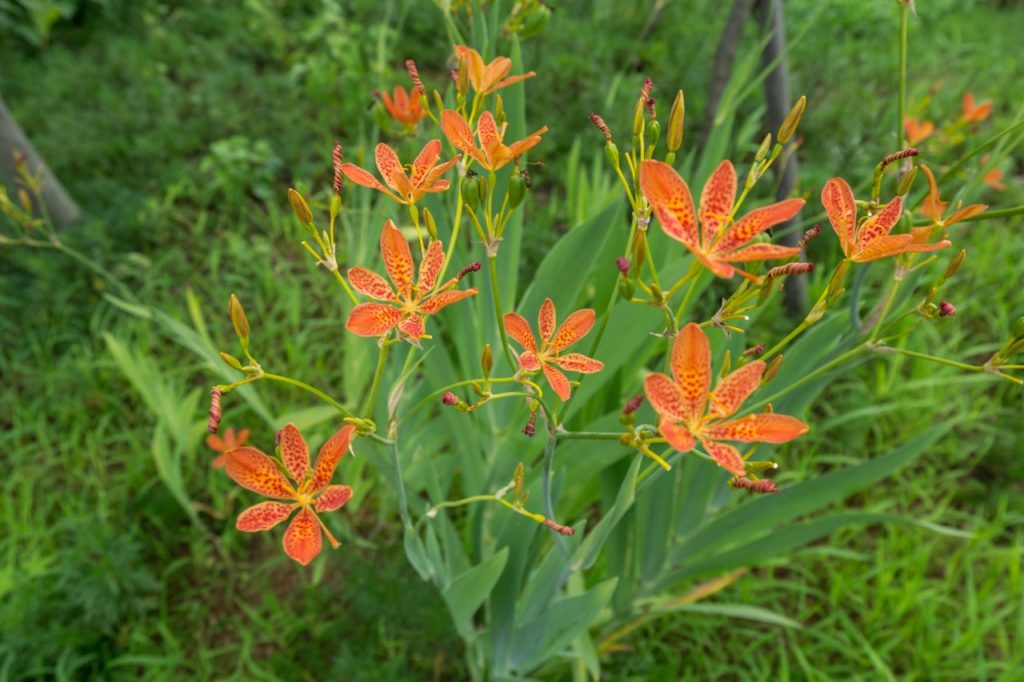
- BOTANICAL NAME: Iris domestica
- HARDINESS RATING: H7
- FLOWERING SEASON(S): summer
- SUNLIGHT: full sun / partial shade
- EXPOSURE: sheltered
- SOIL PREFERENCE: clay or loam; any pH
- SIZE: 0.5-1m in height, 0.1-0.5m spread
The name here is somewhat misleading, since there are no black tones nor berries in sight, and the plant is not even a true lily!
Instead, it belongs to the iris family – but don’t hold that against it.
The delicate orange blossoms, speckled with delightful red spots, can last for several months and brighten up any space.
2) Blanket Flower

- BOTANICAL NAME: Gaillardia pulchella
- HARDINESS RATING: H4
- FLOWERING SEASON(S): summer / autumn
- SUNLIGHT: full sun
- EXPOSURE: exposed / sheltered
- SOIL PREFERENCE: chalk, loam, sand; any pH
- SIZE: 0.1-0.5m in height, 0.1-0.5m spread
From its bulbous dark-red stigma, the blanket flower gradually softens into orange and yellow at its tips.
This makes for a supremely warm and autumnal sight for sore eyes that is every bit as enticing to butterflies as it is to humans.
It’s hardy enough and overwinters well, so should thrive in most parts of the UK.
3) Orange Ball Tree
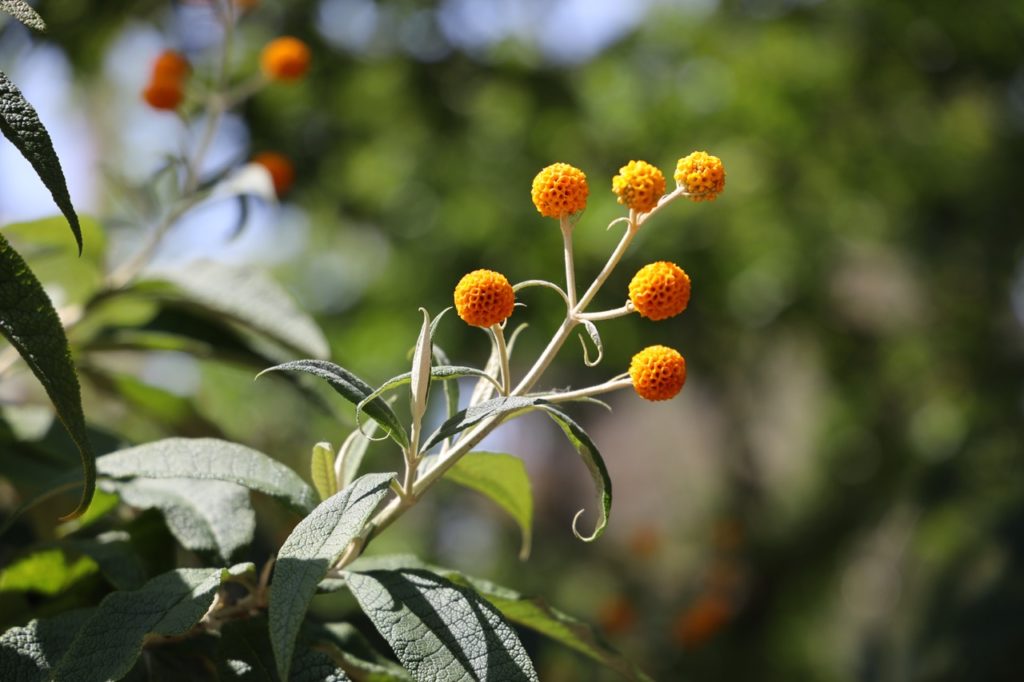
- BOTANICAL NAME: Buddleja globosa
- HARDINESS RATING: H5
- FLOWERING SEASON(S): summer
- SUNLIGHT: full sun / partial shade
- EXPOSURE: sheltered
- SOIL PREFERENCE: all soil types; any pH
- SIZE: 4-8m in height, 4-8m spread
This semi-evergreen shrub can reach a whopping 5m in height, so bear that in mind when selecting and planting it.
The dark green leaves resemble snake tongues, while the globose rosettes of the orange flower heads are around 2cm in diameter and appear without fail in the early summer months.
4) Butterfly Weed
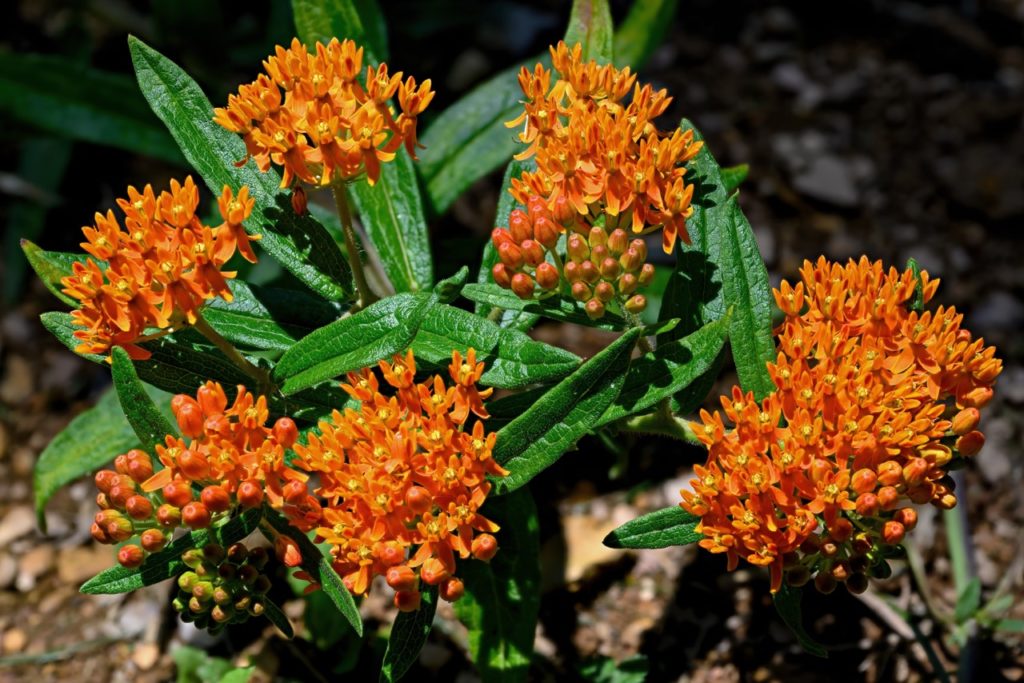
- BOTANICAL NAME: Asclepias tuberosa
- HARDINESS RATING: H4
- FLOWERING SEASON(S): summer / autumn
- SUNLIGHT: full sun
- EXPOSURE: sheltered
- SOIL PREFERENCE: clay, loam, sand; acidic or alkaline pH
- SIZE: 0.5-1m in height, 0.1-0.5m spread
A magnet for butterflies and honeybees, this attractive plant is considered an invasive weed and will spread rapidly if left unattended.
Having said that, it’s not the worst problem in the world, since the dainty clusters of orange blossoms bobbing atop the vibrancy of its green foliage is a beautiful sight in its own right.
5) California Poppy
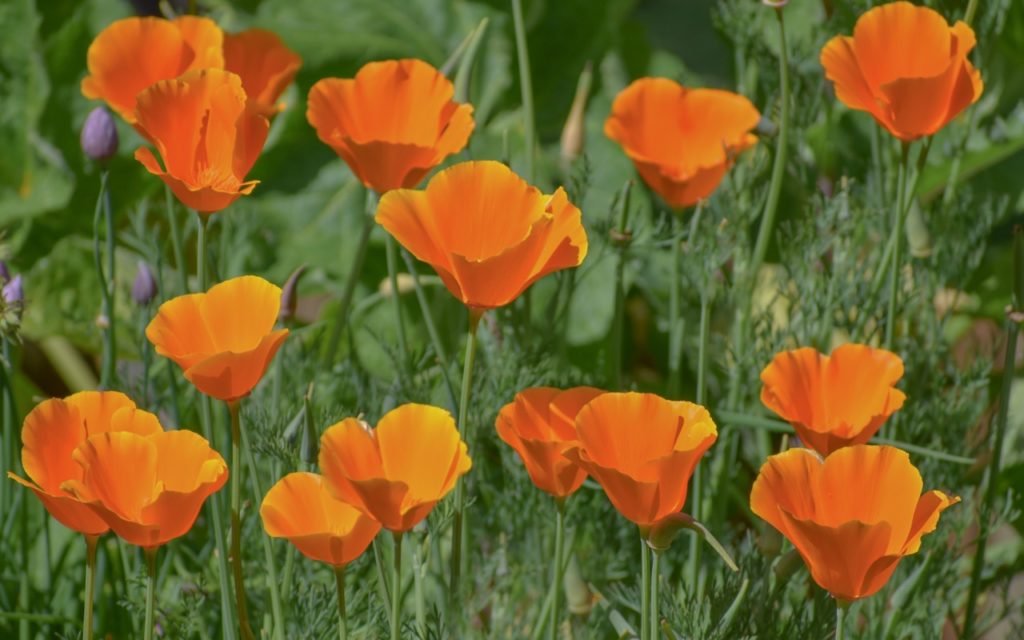
- BOTANICAL NAME: Eschscholzia californica
- HARDINESS RATING: H3
- FLOWERING SEASON(S): summer
- SUNLIGHT: full sun
- EXPOSURE: exposed / shelteredf
- SOIL PREFERENCE: loam or sand; any pH
- SIZE: 0.1-0.5m in height, 0.1-0.5m spread
The cupped blossoms of the California poppy seem to spring up overnight, carpeting the surrounding area in a wave of orange vitality.
Although they grow very fast, their beauty is ephemeral; you’ll struggle to even put picked flowers in a vase before their blooms wilt away.
“As mentioned, California poppies are not perennial in the UK and, although you can buy seeds, you are more likely to have them self-seed from neighbouring gardens,” shares Master Horticulturist Dan Ori.
“Once established, they may or may not be a nice surprise as they pop up unexpectedly around your garden.”
They will need to be grown as annuals in colder areas of the UK.
6) Canna Lily

- BOTANICAL NAME: Canna × generalis
- HARDINESS RATING: H2
- FLOWERING SEASON(S): summer / autumn
- SUNLIGHT: full sun
- EXPOSURE: sheltered
- SOIL PREFERENCE: all soil types; any pH
- SIZE: 0.5-1m in height, 0.1-0.5m spread
Offering an excellent burst of colour and very little in the way of upkeep, canna lilies are far hardier than their extravagant aesthetics might suggest.
Both flowers and foliage will last for many months throughout the year and can be overwintered indoors to act as perennials, but if planted outdoors, they’ll typically grow as annuals.
“Canna lilies are not perennial in the UK, but they do make a good houseplant if the room is not too dry, so I recommend trying to overwinter them,” says Dan.
“It is common for cannas to be overwatered indoors during the winter, often because they are in pot covers that allow them to sit in water.
“When growing indoors, other than not overwatering, my top advice would be to bring them indoors during early autumn and keep them out of cold drafts.”
7) Chrysanthemum

- BOTANICAL NAME: Chrysanthemum ‘Sicardo Orange’
- HARDINESS RATING: H3
- FLOWERING SEASON(S): autumn
- SUNLIGHT: full sun
- EXPOSURE: sheltered
- SOIL PREFERENCE: loam; neutral pH
- SIZE: 0.1-0.5m in height, 0.1-0.5m spread
Chrysanthemums are often associated with the colour red but are actually available in a variety of hues, including a brilliant orange that is guaranteed to add punch and pizzazz to any arrangement.
They can reach up to 90cm in height and will do best if treated to frequent watering due to their shallow rooting habits.
8) Shrubby Cinquefoil

- BOTANICAL NAME: Potentilla fruticosa ‘Hopleys Orange’
- HARDINESS RATING: H7
- FLOWERING SEASON(S): summer / autumn
- SUNLIGHT: full sun / partial shade
- EXPOSURE: exposed / sheltered
- SOIL PREFERENCE: chalk, loam, sand; any pH
- SIZE: 0.5-1m in height, 0.5-1m spread
This gorgeous perennial bush is populated with an abundance of button-shaped blooms which last throughout the summer months.
It’s a fast grower and can exceed 2m in height and spread if left to its own devices, while it’s also resistant to most types of pests and predators.
9) Dahlia
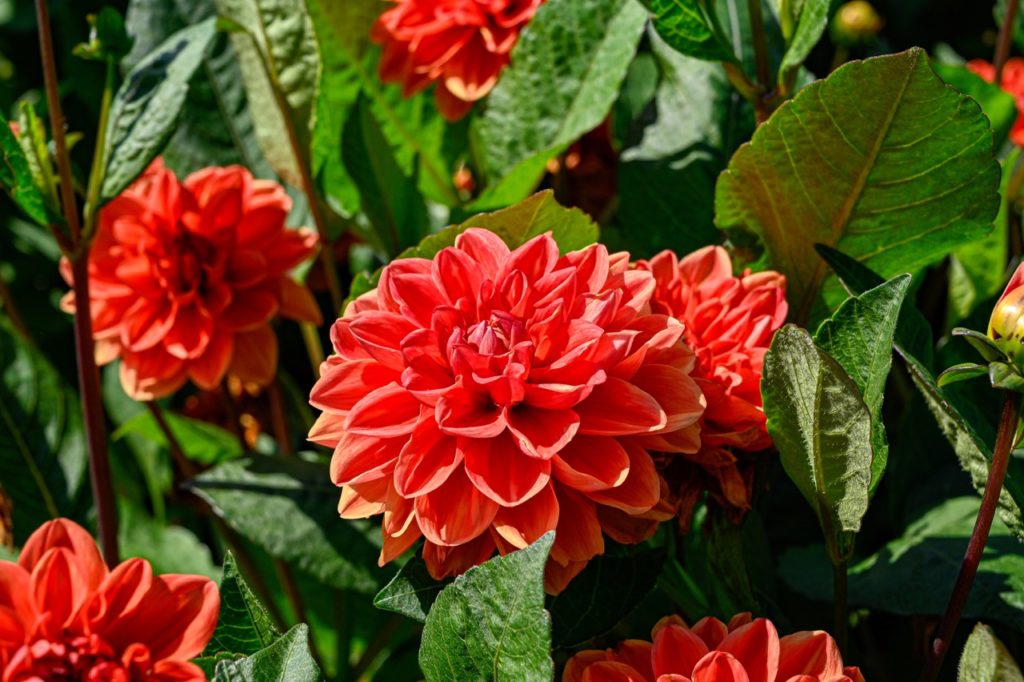
- BOTANICAL NAME: Dahlia ‘Orange Nugget’
- HARDINESS RATING: H3
- FLOWERING SEASON(S): summer / autumn
- SUNLIGHT: full sun
- EXPOSURE: sheltered
- SOIL PREFERENCE: clay, loam, sand; any pH
- SIZE: 0.5-1m in height, 0.5-1m spread
Reminiscent of the chrysanthemum, the dahlia boasts a fuller, more-rounded architecture to its rosette and dainty points at the tips of its petals.
Of course, dahlias are available in a range of colours, but orange varieties can really spice up their surroundings.
10) Daylily

- BOTANICAL NAME: Hemerocallis fulva
- HARDINESS RATING: H7
- FLOWERING SEASON(S): summer
- SUNLIGHT: full sun / partial shade
- EXPOSURE: exposed / sheltered
- SOIL PREFERENCE: all soil types; any pH
- SIZE: 0.5-1m in height, 0.5-1m spread
Another plant whose beauty is short and sweet, the day-long duration of the blooms gives ‘the daylily’ its name.
Not to worry, however, since a single plant can produce hundreds upon hundreds of flowers across the season.
Once established, they require very little in the way of upkeep indeed.
“Daylily varieties are my go-to plants when I need an orange perennial,” explains Dan.
“Their ability to harmonise in a border with so many other plants while still being showy is what makes them special to me.”
11) Gerbera Daisy
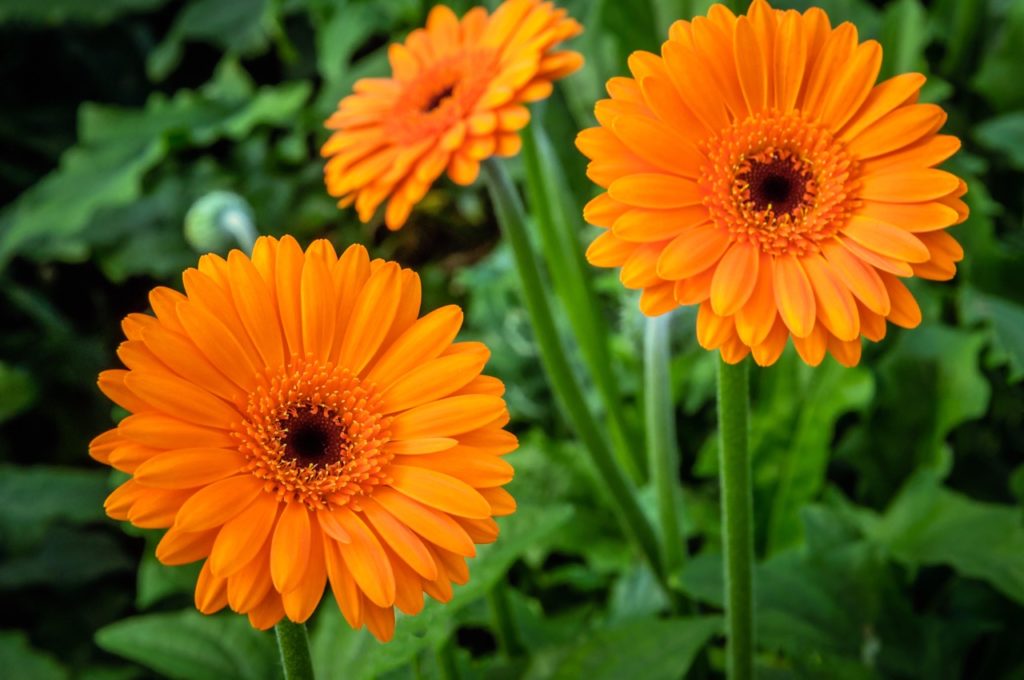
- BOTANICAL NAME: Gerbera ‘Sweet Sunset’
- HARDINESS RATING: H3
- FLOWERING SEASON(S): spring / summer / autumn
- SUNLIGHT: full sun
- EXPOSURE: sheltered
- SOIL PREFERENCE: chalk, loam, sand; any pH
- SIZE: 0.1-0.5m in height, 0.1-0.5m spread
Native to South Africa, Gerbera daisies prefer full sun and warmer temperatures, though hybrid varieties have been developed which can withstand colder climes.
Their beautiful wheel-like flower heads should be pinched off as soon as they begin to wilt in order to prompt fresh growth and prolong the blooming season.
12) Avens

- BOTANICAL NAME: Geum ‘Totally Tangerine’
- HARDINESS RATING: H7
- FLOWERING SEASON(S): spring / summer / autumn
- SUNLIGHT: full sun
- EXPOSURE: exposed / sheltered
- SOIL PREFERENCE: all soil types; any pH
- SIZE: 0.5-1m in height, 0.1-0.5m spread
A member of the rose family, geums are low-maintenance plants which often flower from spring all the way into autumn.
Available with red, orange and yellow flowers, their growing habits (up to 50cm) makes them an ideal choice for the centre of a mixed border.
13) Giant Montbretia
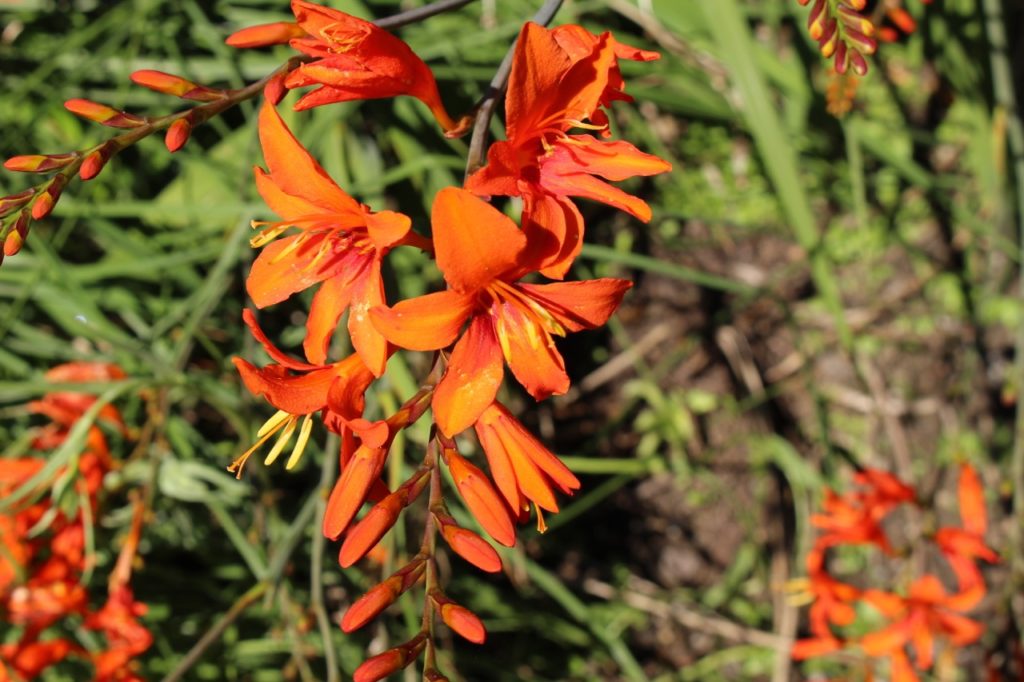
- BOTANICAL NAME: Crocosmia masoniorum
- HARDINESS RATING: H4
- FLOWERING SEASON(S): summer
- SUNLIGHT: partial shade
- EXPOSURE: sheltered
- SOIL PREFERENCE: all soil types; any pH
- SIZE: 1-1.5m in height, 0.1-0.5m spread
As the name suggests, these attractive plants can exceed 1m in height and as such, are better suited to the rear of your display.
Their clusters of orangey-red flowers appear in late summer from July to August, but their swordlike foliage should provide attraction year-round.
This plant can be invasive if left unattended.
14) Globe Flower
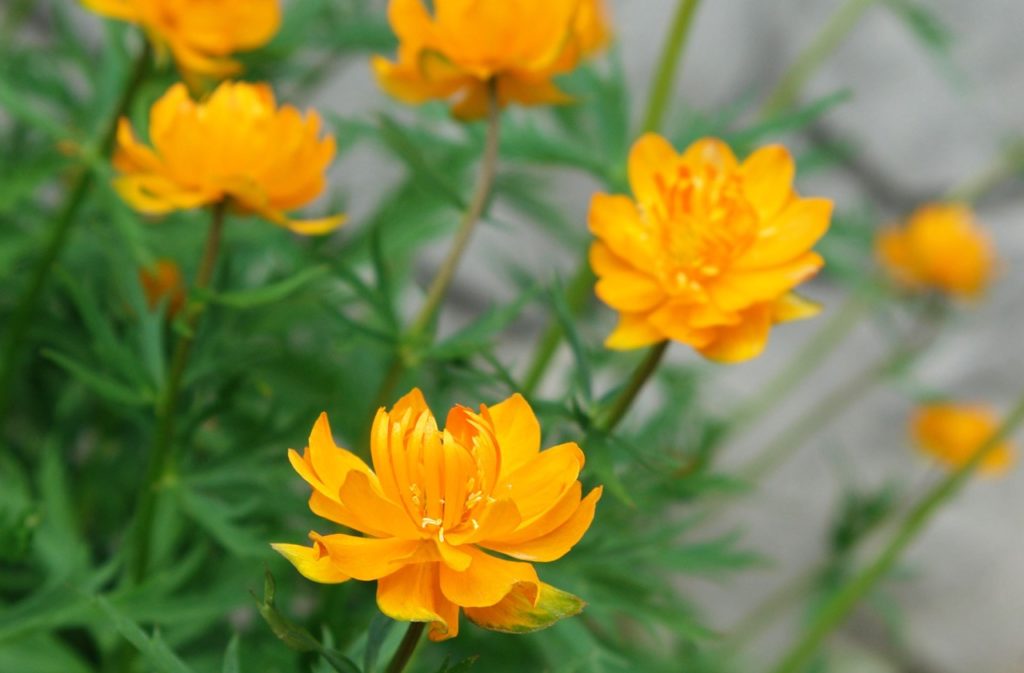
- BOTANICAL NAME: Trollius × cultorum ‘Orange Princess’
- HARDINESS RATING: H7
- FLOWERING SEASON(S): summer
- SUNLIGHT: full sun / partial shade
- EXPOSURE: exposed / sheltered
- SOIL PREFERENCE: clay or loam; any pH
- SIZE: 0.5-1m in height, 0.1-0.5m spread
Extremely versatile, globe flowers love moisture and therefore do best when situated next to a pond, stream or bog garden.
Having said that, their buttercup-like blossoms will liven up any bed or border with minimum fuss, as long as you remember to keep them well hydrated.
15) Golden Pea
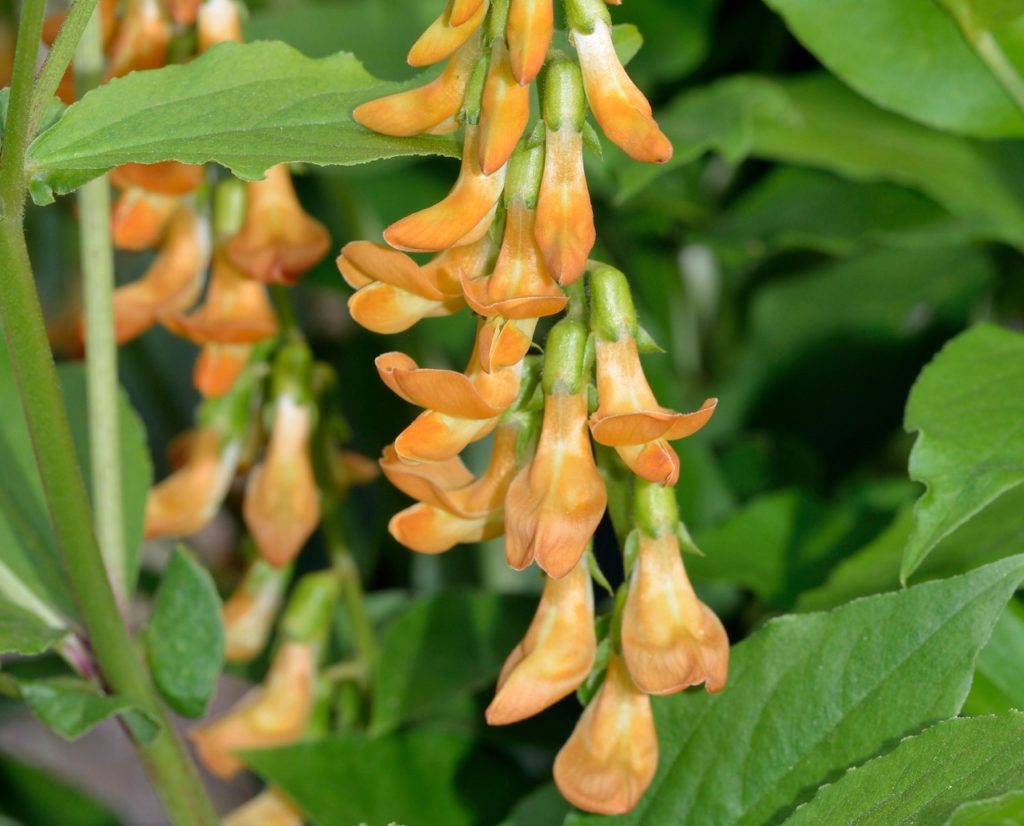
- BOTANICAL NAME: Lathyrus aureus
- HARDINESS RATING: H6
- FLOWERING SEASON(S): spring / summer
- SUNLIGHT: full sun / partial shade
- EXPOSURE: exposed / sheltered
- SOIL PREFERENCE: clay, loam, sand; any pH
- SIZE: 0.5-1m in height, 0.1-0.5m spread
Golden Peas belong to the Lathyrus family, some of which are cultivated for food production.
However, home growers should simply marvel at the profusion of golden-orange flower heads which appear in early summer on each of its upright stems.
16) Hawkweed
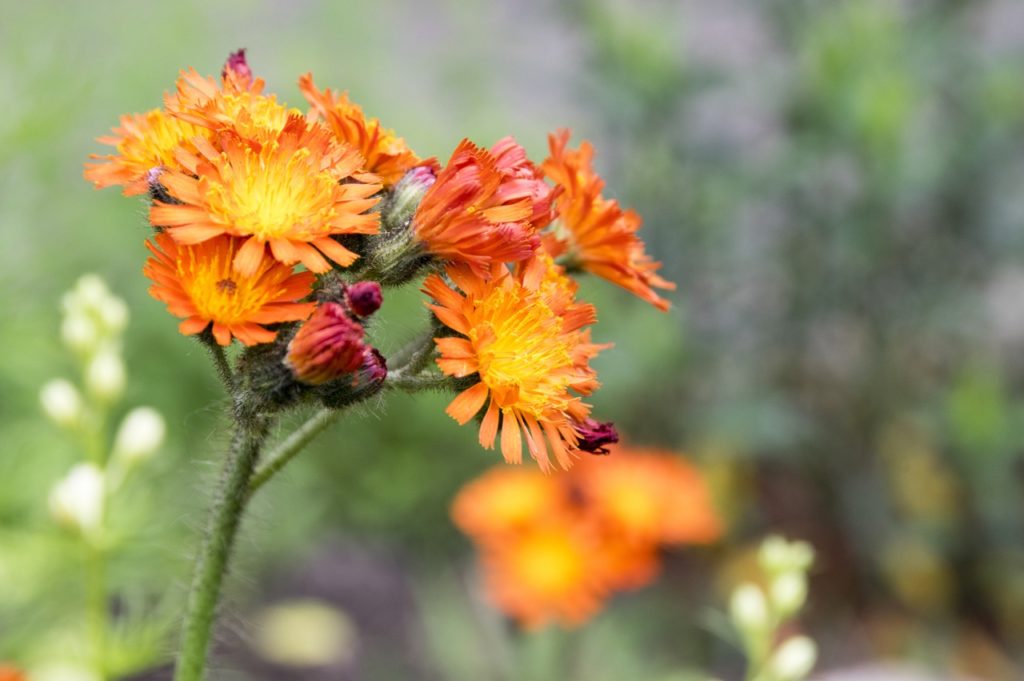
- BOTANICAL NAME: Hieracium aurantiacum
- HARDINESS RATING: H5
- FLOWERING SEASON(S): summer
- SUNLIGHT: full sun / partial shade
- EXPOSURE: exposed / sheltered
- SOIL PREFERENCE: chalk, loam, sand; any pH
- SIZE: 0.1-0.5m in height, 0.5-1m spread
Hawkweed is notable for the architectural intrigue and bright orange colour of its blossoms, which appear between June and August each year.
As the ‘weed’ part of its name suggests, it’s invasive and will spread out of control once established, so bear that in mind when choosing a location to plant it.
17) Helenium

- BOTANICAL NAME: Helenium ‘Sahin’s Early Flowerer’
- HARDINESS RATING: H7
- FLOWERING SEASON(S): summer / autumn
- SUNLIGHT: full sun
- EXPOSURE: exposed / sheltered
- SOIL PREFERENCE: all soil types; any pH
- SIZE: 0.5-1m in height, 0.1-0.5m spread
Characterised by bulbous stamens and thin, daisy-like petals, heleniums grow to a reasonable height and are often favoured for providing background colour.
18) Himalayan Spurge

- BOTANICAL NAME: Euphorbia griffithii
- HARDINESS RATING: H7
- FLOWERING SEASON(S): summer
- SUNLIGHT: partial shade
- EXPOSURE: exposed / sheltered
- SOIL PREFERENCE: clay or loam; any pH
- SIZE: 0.5-1m in height, 0.5-1m spread
Native to Bhutan, Tibet and regions of southern China, the Himalayan spurge has dark red stems supporting bright green leaves and red or orange blossoms in the early summertime.1Euphorbia wallichii – Wallich Spurge. (n.d.). Flowers of India. Retrieved March 21, 2023, from https://www.flowersofindia.net/catalog/slides/Wallich%20Spurge.html
It’s fast-spreading and can sometimes be invasive.
19) Georgian Fleabane
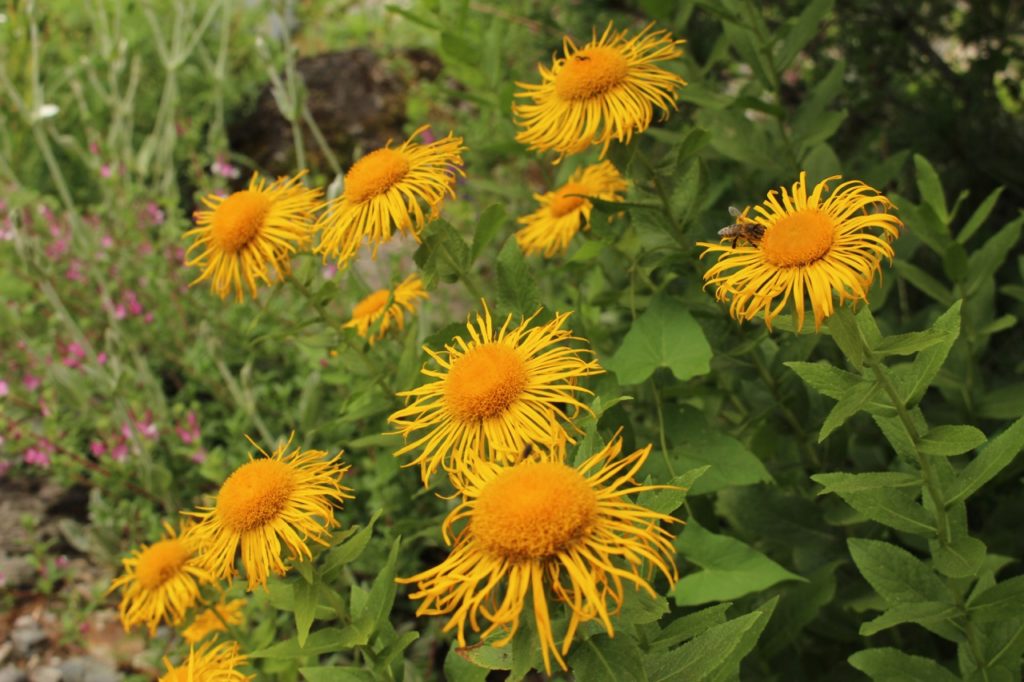
- BOTANICAL NAME: Inula orientalis
- HARDINESS RATING: H6
- FLOWERING SEASON(S): summer
- SUNLIGHT: full sun / partial shade
- EXPOSURE: sheltered / exposed
- SOIL PREFERENCE: all soil types; any pH
- SIZE: 0.1-0.5m in height, 0.1-0.5m spread
With large disc-like blossoms reminiscent of an oversized common daisy, Inula orientalis hails from Asia and is fully hardy for cultivation in the UK.
It’s a versatile little plant which will do well in almost all conditions, except waterlogged terrain with no sun exposure – but that’s the same for most perennials!
20) Iris

- BOTANICAL NAME: Iris ‘Orange Harvest’
- HARDINESS RATING: H7
- FLOWERING SEASON(S): spring / summer / autumn
- SUNLIGHT: full sun
- EXPOSURE: exposed / sheltered
- SOIL PREFERENCE: loam or sand; acidic to neutral pH
- SIZE: 0.5-1m in height, 0.1-0.5m spread
With their 80cm stature and paper-like flowers, irises are fragile but fascinating additions to your garden.
They’re generally quite low-maintenance creatures but don’t do well when starved of water, so take care to make sure their soil doesn’t dry out completely.
Their flowers appear between May and July.
21) Lantana

- BOTANICAL NAME: Lantana camara
- HARDINESS RATING: H1C
- FLOWERING SEASON(S): spring / summer / autumn
- SUNLIGHT: full sun
- EXPOSURE: sheltered
- SOIL PREFERENCE: all soil types; any pH
- SIZE: 1-1.5m in height, 1-1.5m spread
These vining plants look every bit as attractive when climbing up a trellis, tree branch or exterior wall as they do when trailing from a hanging basket.
They come in a variety of different colours, from blue to white to orange, and will thrive if treated to well-draining soil and plenty of irrigation.
They will need overwintering indoors to survive as perennials in the UK.
“You may find Lantana hard to overwinter, which is why I regard it as an annual and sow new plants each year,” Dan says.
22) Ligularia

- BOTANICAL NAME: Ligularia dentata
- HARDINESS RATING: H6
- FLOWERING SEASON(S): summer / autumn
- SUNLIGHT: full sun / partial shade
- EXPOSURE: sheltered
- SOIL PREFERENCE: all soil types; any pH
- SIZE: 1-1.5m in height, 0.5-1m spread
Almost as popular for their lush, lance-like foliage as they are for their yellow and orange blossoms, ligularias are often known as leopard plants for the combination of colours on their flower heads.
Their Latin name comes from the word for tongue and derives from the shape of the petals emanating from the central disc.2A Grammatical Dictionary of Botanical Latin. (n.d.). Missouri Botanical Garden. Retrieved March 21, 2023, from https://www.mobot.org/mobot/latindict/keyDetail.aspx?keyWord=lingua
23) Monkey Flower
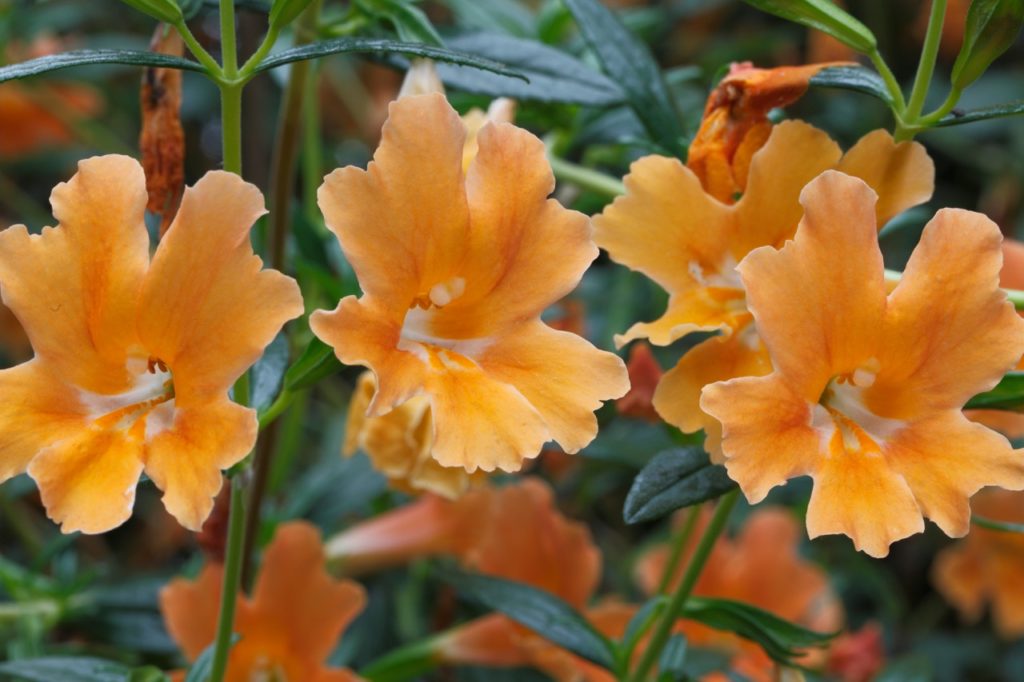
- BOTANICAL NAME: Mimulus aurantiacus
- HARDINESS RATING: H2
- FLOWERING SEASON(S): summer / autumn
- SUNLIGHT: full sun / partial shade
- EXPOSURE: exposed / sheltered
- SOIL PREFERENCE: all soil types; any pH
- SIZE: 0.5-1m in height, 0.5-1m spread
Monkey flowers gained their common name due to the assertion that the petals on some varieties look like the face of our simian friends, but you might have to use your imagination a little bit to see the resemblance!
Nonetheless, their fused petals and bright colours are supremely attractive, meaning they’ve spread far beyond their native Americas.
Unfortunately they will not survive the winter period outdoors in the United Kingdom.
“Mimulus aurantiacus is one to grow under winter-heated glass, so it is best not to regard it as an outdoor plant, although for some it is worth the work of moving large containers to have it outside in the summer,” says Dan.
24) Orange Coneflower

- BOTANICAL NAME: Echinacea ‘orange passion’
- HARDINESS RATING: H5
- FLOWERING SEASON(S): summer / autumn
- SUNLIGHT: full sun
- EXPOSURE: exposed / sheltered
- SOIL PREFERENCE: chalk, loam, sand; any pH
- SIZE: 0.5-1m in height, 0.1-0.5m spread
Orange coneflowers are among the most popular orange perennials in the UK and elsewhere.
The yellowy-orange petals are arranged in a pleasing star-like formation around a dark central stamen, while the hairy texture is unique and soft to the touch.
25) Chinese Trumpet Vine

- BOTANICAL NAME: Campsis grandiflora
- HARDINESS RATING: H4
- FLOWERING SEASON(S): summer / autumn
- SUNLIGHT: full sun
- EXPOSURE: sheltered
- SOIL PREFERENCE: all soil types; any pH
- SIZE: 8-12m in height, 2.5-4m spread
Originally hailing from the tropical climates of Paraguay and Brazil, the orange trumpet might be difficult to establish in the UK.3Campsis radicans. (n.d.-b). Missouri Botanical Gardens. Retrieved March 21, 2023, from https://www.missouribotanicalgarden.org/PlantFinder/PlantFinderDetails.aspx?kempercode=b840
If you succeed, however, you’ll be treated to fantastic evergreen vines populated by orange tubular blossoms in the wintertime, adding some much-needed life to your garden in the colder months.
26) Peony
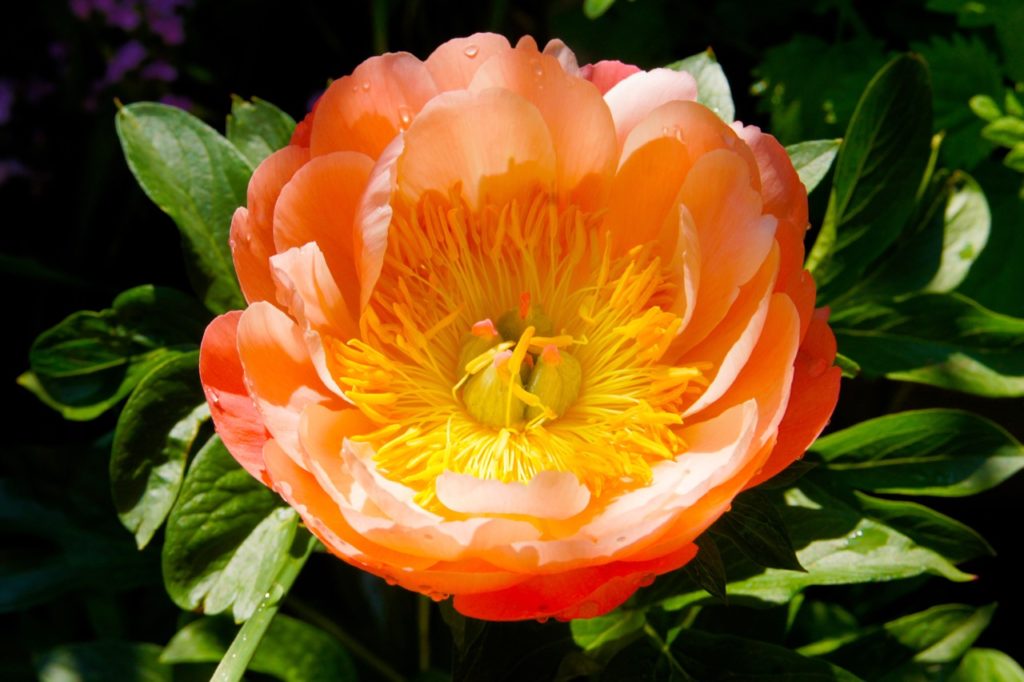
- BOTANICAL NAME: Paeonia ‘Coral Charm’
- HARDINESS RATING: H6
- FLOWERING SEASON(S): spring / summer
- SUNLIGHT: full sun / partial shade
- EXPOSURE: sheltered
- SOIL PREFERENCE: clay, loam, sand; any pH
- SIZE: 0.5-1m in height, 0.5-1m spread
Another staple of the Great British gardening scene, peonies come in all types of shapes, colours and sizes.
The orange-coloured specimen above is a personal favourite of mine and can change its tones as it matures, so keep an eye out for a mesmerising metamorphosis throughout its blooming season.
27) Persian Buttercup
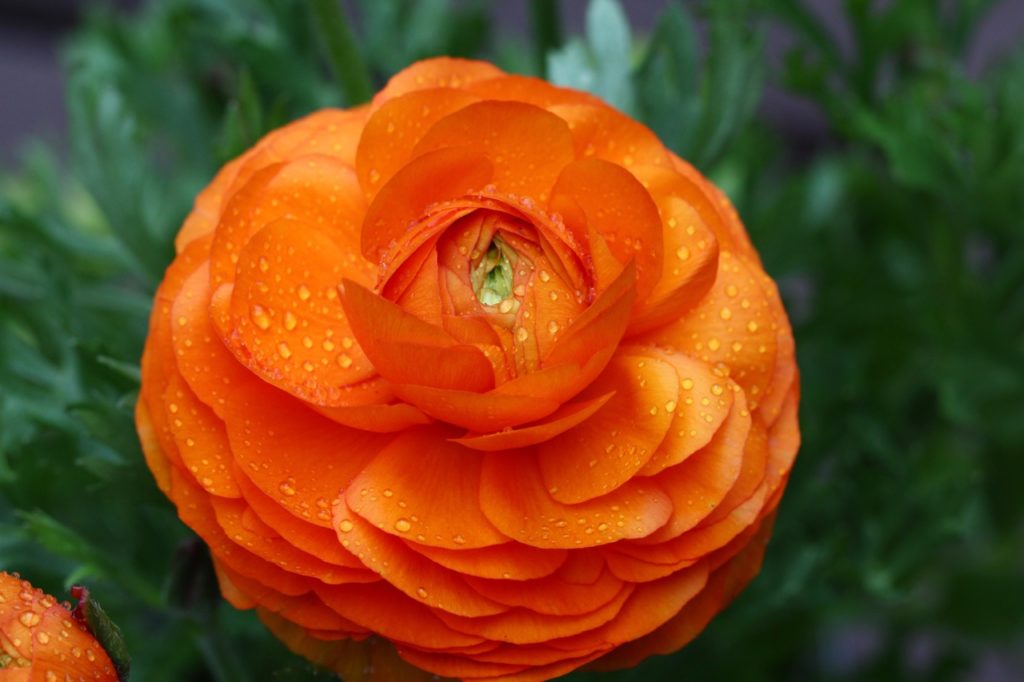
- BOTANICAL NAME: Ranunculus asiaticus
- HARDINESS RATING: H4
- FLOWERING SEASON(S): spring / summer
- SUNLIGHT: full sun
- EXPOSURE: sheltered
- SOIL PREFERENCE: loam or sand; any pH
- SIZE: 0.1-0.5m in height, 0.1-0.5m spread
The flower heads of this beautiful perennial look like the paper-mâché creations that we used to knock together at school, though nature is a far better craftsman than I or my classmates ever were.
Its preference for cooler climes makes it ideal for UK cultivation, as in hotter regions, the petals will simply wither and die.
“Choose your varieties with care, as only a few Ranunculus are perennial in the UK,” warns Dan.
28) Peruvian Lily
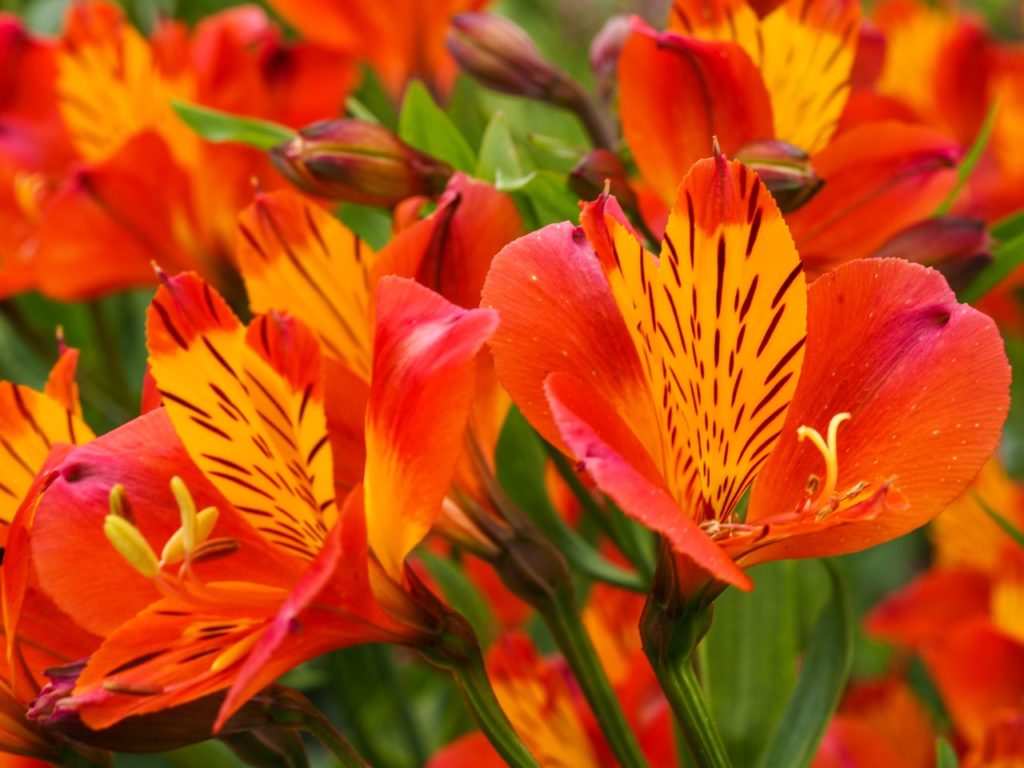
- BOTANICAL NAME: Alstroemeria ‘Orange Glory’
- HARDINESS RATING: H4
- FLOWERING SEASON(S): summer / autumn
- SUNLIGHT: full sun / partial shade
- EXPOSURE: sheltered
- SOIL PREFERENCE: all soil types; any pH
- SIZE: 0.5-1m in height, 0.5-1m spread
This bushy perennial can achieve almost 1m in height with a similar spread, so remember to give it plenty of elbow room when planting.
Once flowering begins, you’ll be delighted with the range of lily-like flower heads which appear all over its body, the dark flecks offsetting the brilliance of its orange petals.
29) Rainbow Bitter Root

- BOTANICAL NAME: Lewisia cotyledon ‘rainbow’
- HARDINESS RATING: H4
- FLOWERING SEASON(S): spring / summer
- SUNLIGHT: partial shade
- EXPOSURE: exposed / sheltered
- SOIL PREFERENCE: loam or sand; acidic to neutral
- SIZE: 0.1-0.5m in height, 0.1-0.5m spread
This herbaceous evergreen perennial is often mistaken for a succulent, due to the waxiness of its leaves and its tolerance for drought.
Despite the interesting foliage, it’s the star-shaped flowers which are the real attraction for the eye-catching array of pinks, reds, oranges and yellows which adorn them.
30) Rock Rose

- BOTANICAL NAME: Helianthemum ‘Coppernob’
- HARDINESS RATING: H4
- FLOWERING SEASON(S): spring / summer
- SUNLIGHT: full sun
- EXPOSURE: exposed / sheltered
- SOIL PREFERENCE: all soil types; alkaline to neutral pH
- SIZE: 0.1-0.5m in height, 0.1-0.5m spread
The deep orange of the tissue-paper petals on a rock rose plant looks particularly stunning set against the lush greenery of its foliage.
It’s an excellent choice for beginners, given that it will survive in almost all conditions, including with very little water, but it does best in full sunlight.
31) Red-Hot Poker
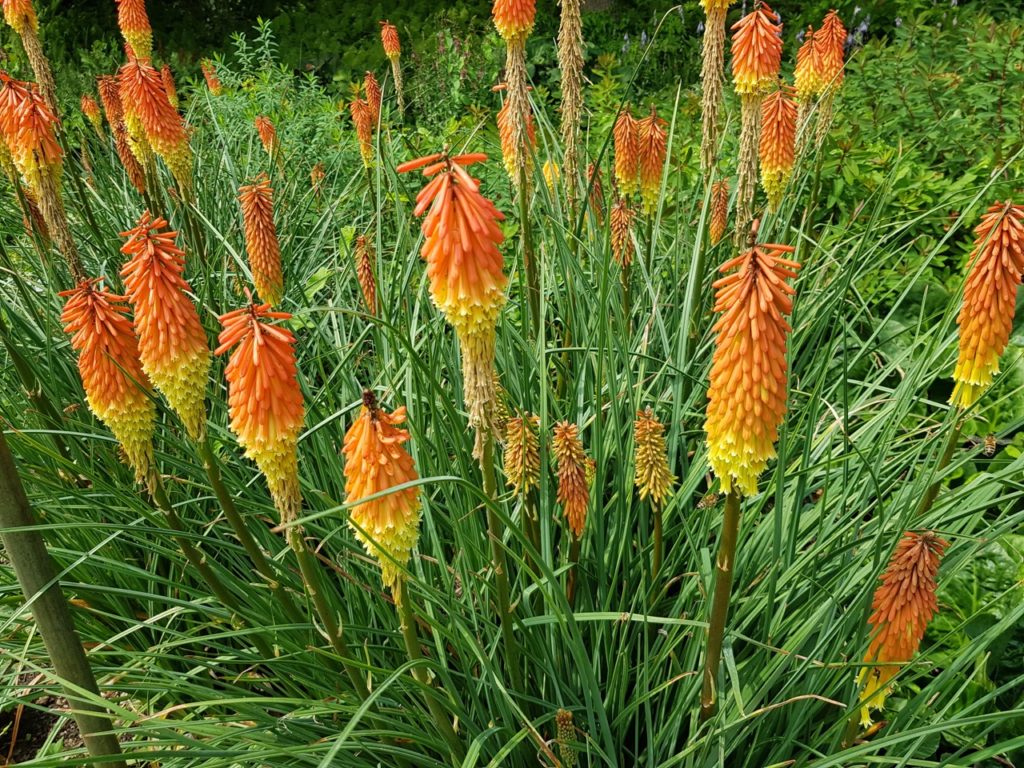
- BOTANICAL NAME: Kniphofia uvaria
- HARDINESS RATING: H5
- FLOWERING SEASON(S): summer / autumn
- SUNLIGHT: full sun
- EXPOSURE: exposed / sheltered
- SOIL PREFERENCE: loam or sand; any pH
- SIZE: 0.5-1m in height, 1-1.5m spread
There are few perennials more impressive than the torch lily, which gains its name from the changing colours of the flowers on the conical stem, which graduates from yellow nearer the base through apricot and coral up to a soft red at its apex.
As such, it really does resemble a flaming torch.
32) Tulip
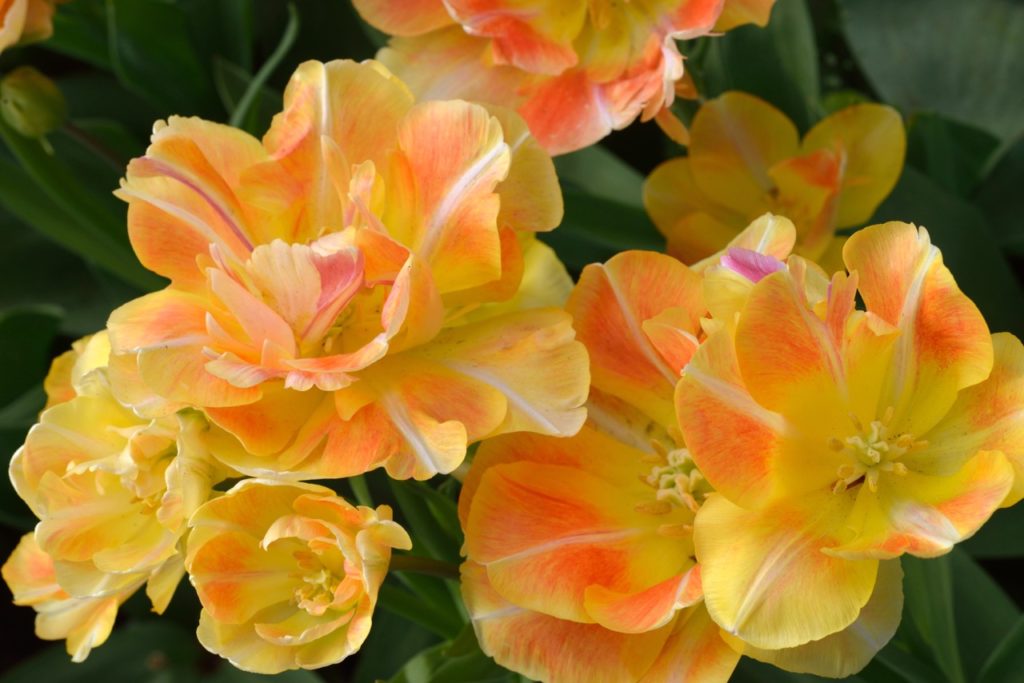
- BOTANICAL NAME: Tulipa ‘Orange Angélique’
- HARDINESS RATING: H6
- FLOWERING SEASON(S): spring
- SUNLIGHT: full sun
- EXPOSURE: sheltered
- SOIL PREFERENCE: all soil types; any pH
- SIZE: 0.1-0.5m in height, 0.1-0.5m spread
Tulips come in a wide variety of hues, but there are plenty of oranges cultivars to choose from.
‘William of Orange’, ‘Orange Queen’ and ‘Orange Angelique’ (pictured above) are just some of the options on offer.
Whichever you choose, their mid-range height and soft coral tones make them ideal for the middle of a border.
33) Wallflower

- BOTANICAL NAME: Erysimum cheiri
- HARDINESS RATING: H5
- FLOWERING SEASON(S): spring
- SUNLIGHT: full sun
- EXPOSURE: exposed / sheltered
- SOIL PREFERENCE: chalk, loam, sand; alkaline to neutral pH
- SIZE: 0.1-0.5m in height, 0.1-0.5m spread
Native to southern Europe, the wallflower gains its name from the fact that it’s so adept at dealing with dry soil that it can even sprout from between the silty cracks in brickwork.
Far from being bashful like their human namesakes, however, wallflowers are extremely hardy, yet still very pretty to look at.
Their four-petalled flower heads come in blues, purples, reds, yellows and, of course, oranges.
34) Welsh Poppy
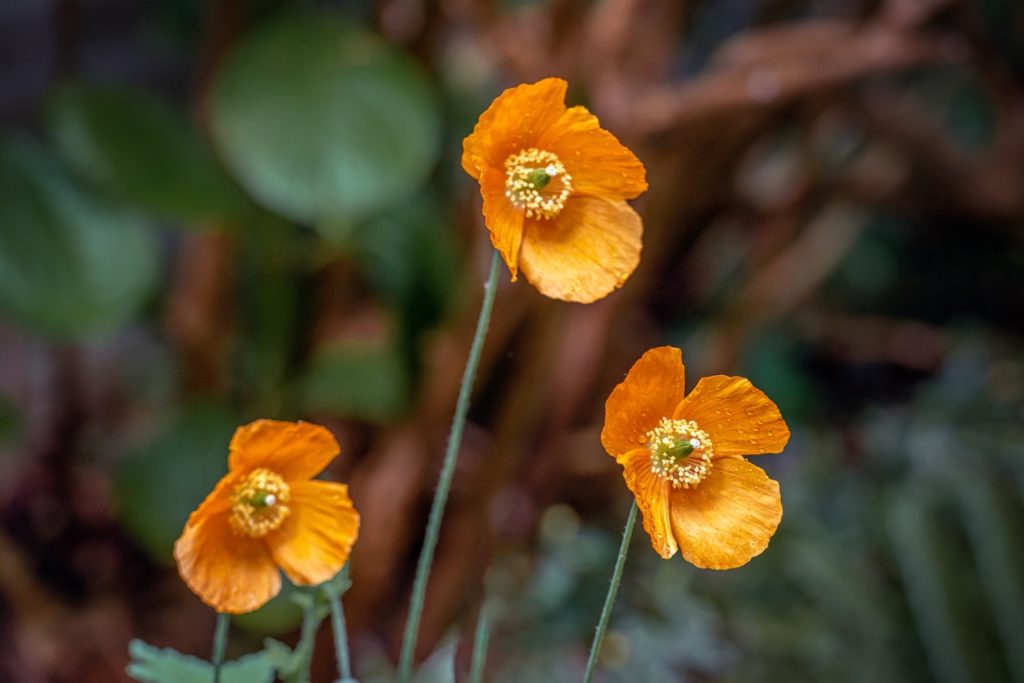
- BOTANICAL NAME: Papaver cambricum
- HARDINESS RATING: H6
- FLOWERING SEASON(S): spring / summer / autumn
- SUNLIGHT: partial shade
- EXPOSURE: sheltered
- SOIL PREFERENCE: clay, loam, sand; acidic to neutral pH
- SIZE: 0.1-0.5m in height, 0.1-0.5m spread
This softly orange poppy is a counterpart to the Californian variety mentioned above, though it differs in its preference for dark and damp locales.
It’s often found in forested areas in the wild and under the shade of walls in captivity, but wherever it’s located, it will invariably attract pollinators by the bucketload.
35) Bird Of Paradise
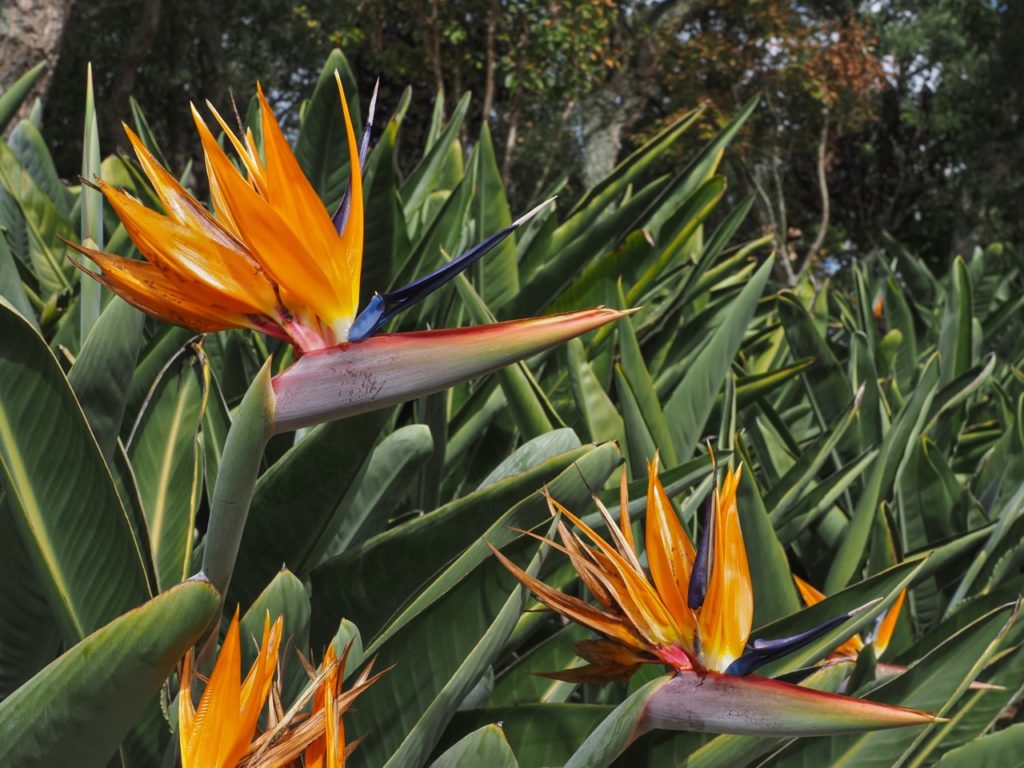
- BOTANICAL NAME: Strelitzia reginae
- HARDINESS RATING: H1B
- FLOWERING SEASON(S): winter / spring
- SUNLIGHT: full sun / partial shade
- EXPOSURE: sheltered
- SOIL PREFERENCE: chalk, loam, sand; any pH
- SIZE: 1-1.5m in height, 0.5-1m spread
Is it a bird? Is it a plane?
Nope, just a dramatically attractive plant.
Capable of growing to almost 2m in height, bird of paradise plants will need plenty of their own space and even more sunlight, though they must be grown exclusively indoors here in the UK.
References
- 1Euphorbia wallichii – Wallich Spurge. (n.d.). Flowers of India. Retrieved March 21, 2023, from https://www.flowersofindia.net/catalog/slides/Wallich%20Spurge.html
- 2A Grammatical Dictionary of Botanical Latin. (n.d.). Missouri Botanical Garden. Retrieved March 21, 2023, from https://www.mobot.org/mobot/latindict/keyDetail.aspx?keyWord=lingua
- 3Campsis radicans. (n.d.-b). Missouri Botanical Gardens. Retrieved March 21, 2023, from https://www.missouribotanicalgarden.org/PlantFinder/PlantFinderDetails.aspx?kempercode=b840


